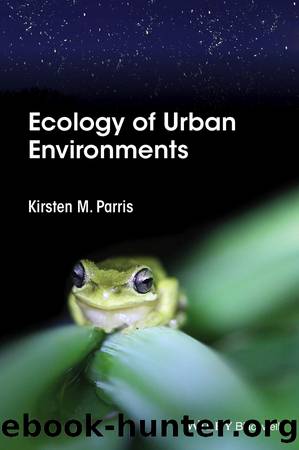Ecology of Urban Environments by Kirsten M. Parris

Author:Kirsten M. Parris [Parris, Kirsten M.]
Language: eng
Format: epub
ISBN: 9781119241157
Publisher: Wiley
Published: 2016-02-29T00:00:00+00:00
Chapter 5
Ecosystem-level responses to urbanization
5.1 Introduction
Population ecology can be understood through the four population processes of births, deaths, immigration and emigration; its focus is on the individuals within a population. Similarly, community ecology can be understood through the four community-level processes of selection, dispersal, ecological drift and evolutionary diversification; its focus is on the species within a community. But how do we characterize the ecology of entire ecosystems? First, we need to clarify what we mean by the term ecosystem. A system is a group of parts that interact with each other via one or more processes, with emergent properties that arise from these interactions. As a consequence, the system as a whole is greater than the sum of its parts (Odum 1983). An ecosystem (short for ecological system) was defined by Tansley (1935) as the collection of living and non-living components in a given place or geographic area, and the network of interactions between them. Therefore, an ecosystem has four broad elements: the living element, comprised of all organisms from the smallest microbes to the tallest trees and the largest animals; the non-living element, comprised of air, water, light, heat and minerals (rock, soil, sand, dust, carbon and other nutrients); the interactions within and between the first two elements; and a designated, physical space within which all these elements exist (Tansley 1935; Keith et al. 2013). Biological, chemical and physical processes occur when two or more components of an ecosystem interact (Odum 1983); examples include photosynthesis, carbon sequestration, evapotranspiration, respiration, predation, nitrogen fixation, decomposition, precipitation, insolation, erosion, the weathering of rocks and minerals and the absorption of water and nutrients by soil (see Box 5.1).
Ecosystem ecology focuses on the ecosystem in its entirety, measuring and modelling the fluxes of energy and materials in, around and out of the system (Loreau 2010). Like ecological communities, ecosystems can be studied across a range of spatial scales from the local to the global, depending on the entity or question of interest (Tansley 1935; Odum 1983; Willis 1997; Loreau 2010). For example, let's consider the ecosystem formed by a watershed or hydrological catchment. The watershed has traditionally been an important scale of analysis in ecosystem ecology (Likens 1992; Groffman et al. 2004) â it is large enough to observe cycles of energy, water and nutrients within the system, but small enough to be relevant for environmental management. A watershed has clear, physical boundaries that define its geographic extent. Within these boundaries, a vast array of biological, chemical and physical processes combine to create cycles of water, carbon and other nutrients, and to capture, transfer and dissipate energy throughout the system (Loreau 2010). The study of ecosystem dynamics is concerned with disturbances or perturbations of ecosystems (both natural and anthropogenic) and their consequences over time and space (Turner et al. 2003; Chapin et al. 2011). Disturbances may include short-term events, such as wildfire, disease, storms and floods, or longer-term processes, such as changes to rainfall and temperature regimes, the clearing of native vegetation and the fragmentation of habitat (White and Pickett 1985; Turner et al 2003).
Download
This site does not store any files on its server. We only index and link to content provided by other sites. Please contact the content providers to delete copyright contents if any and email us, we'll remove relevant links or contents immediately.
ASTROPHYSICS FOR NON-MATHEMATICIANS by Unknown(284)
A Brief Introduction to Classical Mechanics with Illustrative Problems (181 Pages) by Shahen Hacyan(284)
Physics in Minutes by Giles Sparrow(274)
Modern Physics by Gary N. Felder and Kenny M. Felder(252)
Understandable Statistics. Concepts and Methods by Charles Henry Brase Corrinne Pellillo Brase Jason Dolor James Seibert(251)
Calculus - Single and Multivariable 6th ed. by D. Hughes-Hallett(250)
Fundamentals of Physics I by R. Shankar;(237)
Meat Less: The Next Food Revolution by David Julian McClements(231)
A History of Mathematical Impossibility by Lützen Jesper;(230)
Iraq at the Crossroads by Toby Dodge(222)
Principles of Modern Chemistry by David W. Oxtoby H.P. Gillis & Laurie J. Butler(219)
Probabilistic Risk Analysis and Bayesian Decision Theory by Marcel van Oijen & Mark Brewer(218)
A Mathematician Comes of Age by Krantz Steven G(208)
The Parrot in the Mirror by Antone Martinho-Truswell(206)
Practical Math Success in 20 Minutes a Day by Mark A. McKibben(204)
Sensory Ecology, Behaviour, and Evolution by Stevens Martin;(200)
Calculus, Early Transcendentals, International Metric Eighth Edition by James Stewart(196)
Chemistry for the IB Diploma Third edition by Christopher Talbot Chris Davison(191)
Understanding the Universe: From Quarks to the Cosmos (591 pages) by Don Lincoln(190)
